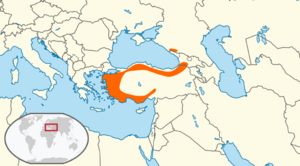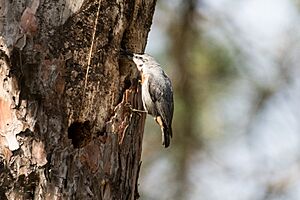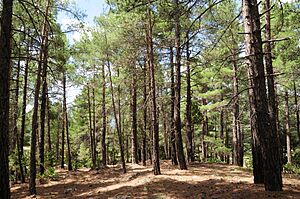Krüper's nuthatch facts for kids
Quick facts for kids Krüper's nuthatch |
|
|---|---|
 |
|
| Male in a pine forest on the island of Lesbos, Greece. | |
| Conservation status | |
| Scientific classification | |
| Genus: |
Sitta
|
| Species: |
krueperi
|
 |
|
| Distribution of the Krüper's nuthatch | |
| Synonyms | |
|
• Sitta krüperi (Pelzeln, 1863) |
|
Krüper's nuthatch (Sitta krueperi) is a species of bird in the family Sittidae. It is a small to medium-sized nuthatch, measuring 12.5 centimetres (4.9 in) in length. The upperparts are blue-gray, with the front half of the crown black in adults of both sexes, but with a less marked in the female rear. The species has a black or gray eyestripe and a prominent white supercilium. The underparts are blue-gray in males and buff-gray in females, with a large, crescent-shaped rufous pectoral patch. The Krüper's nuthatch feeds on insects in the summer and seeds, especially pines, in the fall and winter. Breeding takes place between March and May, and the nest is usually placed in a tree hole. The clutch consists of five to seven eggs, incubated by the female and fed by the male. Both parents take part in feeding the young.
The Krüper's nuthatch is found in pine and other coniferous forests in Turkey, Lesvos, and the Caucasus, largely following the distribution of Turkish pine (Pinus brutia). It is found from sea level up to 2,500 metres (8,200 ft) above sea level in places. This species is one of the small nuthatches of the "canadensis group" and is particularly very close to the Algerian nuthatch (S. ledanti), the only other species in which the black half-crown is found. The Krüper's nuthatch is threatened by habitat loss caused by forestry and especially by tourist development on the Turkish coasts. Although its numbers are declining, the species is considered to be of "least concern" by the International Union for Conservation of Nature.
Contents
Taxonomy

The Krüper's nuthatch was described in 1863 by the Austrian ornithologist August von Pelzeln under the protonym Sitta krüperi, from type material from İzmir. By naming the species in this way, he pays homage to its discoverer, the German ornithologist Theobald Johannes Krüper. Hans Edmund Wolters proposed the division of the genus Sitta into subgenera in 1975–1982. The Krüper's nuthatch is placed in Sitta (Mesositta) (Buturlin, 1916), which also includes the Algerian nuthatch (S. ledanti), Yunnan nuthatch (S. yunnanensis), red-breasted nuthatch (S. canadensis), Chinese nuthatch (S. villosa) and Corsican nuthatch (S. whiteheadi). The Krüper's nuthatch belongs to the species group canadensis. It is most closely related to the Algerian nuthatch. According to the International Ornithological Congress and Alan P. Peterson, no subspecies are distinguished.
Phylogeny
In 1998, Éric Pasquet studied the cytochrome b of the mitochondrial DNA of ten species of nuthatches, including the different species of the Sitta canadensis group, which he defined as six species, which are also sometimes treated as the subgenus Sitta (micrositta) (Buturlin, 1916). The Yunnan nuthatch (S. yunnanensis) was not included in the study. Pasquet concludes that the Krüper's nuthatch is phylogenetically related to the Algerian nuthatch, with both species forming the sister group of a clade that includes the Chinese nuthatch, the Corsican nuthatch, and the red-breasted nuthatch. In 2014, Éric Pasquet and colleagues published a phylogeny based on nuclear and mitochondrial DNA from 21 species of nuthatches and confirmed the 1998 study's relationships within the canadensis group, adding the Yunnan nuthatch, which was found to be the most basal of the species.
The conclusions of the study are in agreement with the morphology of the species, the red-breasted, Corsican, and Chinese nuthatches sharing, in particular as a derivative characteristic, the entirely black crown only present in males, a unique trait in Sittidae and related families. The second clade, grouping together Krüper's and Algerian nuthatches are thought to have the front of the black crown in males, this sexual dimorphism being absent in young individuals.
Phylogeography
A study on the phylogeography of the species was published in 2012, involving five sample sites in Turkey. The authors conclude that there are significant genetic diversities between the different localities, showing that the species occurred in at least three refuges during the last glaciation maximum. The southern populations are significantly different from the northern populations of the country, but the different northern populations have intensively mixed their genes after the glacial retreat, and have quite similar nuclear genetic material, although a marked geographical structure is observed by studying their mitochondrial genomes.
| Nuthatch phylogenic detail according to Pasquet, et al. (2014): | |||||||||||||||||||||||||||||||||
|---|---|---|---|---|---|---|---|---|---|---|---|---|---|---|---|---|---|---|---|---|---|---|---|---|---|---|---|---|---|---|---|---|---|
|
Description
The Krüper's nuthatch is a small to medium-sized nuthatch, measuring 12.5 centimetres (4.9 in) in length. In males and females, the folded wing measures 71–81 millimetres (2.8–3.2 in) and 68–74 millimetres (2.7–2.9 in) respectively, the tail 33–40 millimetres (1.3–1.6 in) and 33–38 millimetres (1.3–1.5 in). The bill measures 17.9–20.2 millimetres (0.70–0.80 in) and the tarsus 16.9–19.3 millimetres (0.67–0.76 in). The adult male weighs 10–14.3 grams (0.35–0.50 oz). The study of 41 different measurements of many individuals across different localities in Turkey showed small variations in size along the range.
The upperparts are blue-gray with a black front crown in adults of both sexes, and the primary and secondary flight feathers are gray-brown. The supercilium is white and underlined by a black eyestripe that is a little less well defined behind the eye. The throat is white and the rest of the underparts are pale gray with a large reddish patch on the crescent-shaped breast. The underwing-coverts are off-white and the undertail is rufous, with white tips. The eye is surrounded by a thin white eye ring, and the iris is dark cinnamon or brown; the bill is dark horn-gray; the upper mandible cutting edge at the base is blue-gray, as is the entire lower mandible base. The legs are gray-brown or dark gray.
The sexual dimorphism is not very marked, especially in summer when the plumage is worn, but the female's crown is less black and less sharply defined at the back, whereas the male's crown is sharply defined in glossy black Female underparts are paler and buff, while the male's are pure gray, verging to blue. The juvenile, on the other hand, is more easily distinguished, having much duller plumage and lacking the black crown; at most, the front of it is darker than the rest of the upperparts. Its russet pectoral patch is not very marked, as are the supercilium and the eyestripe. It can be distinguished from the adult female by its fresh plumage when the feathers of the latter are worn and its dark crown. Adults in their first year sometimes have some lingering brown on the feather tips of their greater coverts. Adults undergo a full post-nuptial moult (from mid-May to early September) and sometimes a partial moult before the breeding season (March), which particularly affects the chest. There is also a partial post-juvenile moult involving the middle coverts. With the front of the crown dark and the marked white supercilium, the Algerian nuthatch has cream or buff-colored underparts and lacks a large russet-brown pectoral patch. This patch is characteristic of the Krüper's nuthatch, as is the marked difference between adults and juveniles.
Ecology and behavior

The Krüper's nuthatch lives alone or in pairs during the breeding season, and the pair stays with their young. In autumn, it is observed in groups of two to five individuals, sometimes taking part in mixed-species foraging flocks.
Vocalizations
The Krüper's nuthatch is a noisy bird, and is often easily identified by its calls. The contact call is a dvui, sometimes made in a dui-dui-dui-dui series and reminiscent of the European greenfinch (Chloris chloris). When agitated, it produces a rough èèhch reminiscent of the Eurasian jay (Garrulus glandarius) or a dry puik. The song is a "tuituituituitui… nasal, alternating high and low notes", with variable rhythm.
Food
The Krüper's nuthatch is an active bird, and it finds its food among the smallest branches in the tops of large trees, but also in other levels of vegetation. It can forage in bushes, and even feed on the ground. It feeds mainly on insects during the breeding season, but when these become scarce, in autumn and winter, it consumes seeds of pine and other conifers. Insects are gleaned along branches, or caught in flight, and conifer seeds are extracted from cone scales with the bill, before being wedged into a crack in the bark and hammered open. The Krüper's nuthatch also makes food caches that can be used when moisture closes the pine cones, making their seeds inaccessible, and the existence of these larders may explain the bird's territoriality, even outside the breeding season.
Breeding
The breeding season takes place from mid-March to mid-May in Turkey, the date depending on the location and altitude. In southern Anatolia, egg laying begins at the end of March; in the Caucasus, it takes place in April–May. There is only one brood per year. The nest is often placed in the hole of a conifer and far from the ground. A study conducted out over four breeding seasons in southern Turkey showed that nests were built to a height of nearly 12 m (470 in), with extremes between 2.1 m (83 in) and 24 m (940 in), and were often facing east. The Krüper's nuthatch usually uses already existing cavities that have been simply cleaned out, especially by the female, but can dig its own hole in dead trunks and branches. Eggs have been observed on the top of a stump or on a pile of twigs at the fork of a tree, but these unusual nesting sites may only be used when cavities are unavailable.
Unlike other nuthatches, the Krüper's nuthatch does not build the entrance to its hole with mud or resin. The bottom of the nest is lined with bark chips, rotten wood and pine cone scales, covered with moss, hair, wool, and feathers. The female does most of the work and lays four to seven eggs, usually five or six, measuring 17 mm × 13 mm (0.67 in × 0.51 in), creamy white with small red or purplish spots and speckles, mostly concentrated at the larger end. Incubation lasts 12 to 17 days and is performed by the female alone, fed by the male. The female also incubates the young, but both parents take part in the feeding. The young are mainly fed on beetles, insect larvae, lepidoptera, and earthworms. On average, four young are fledged at 15–19 days of age.
Parasites
In a Turkish study published in 2012, the Krüper's nuthatch was found to host blood protists of the genera Haemoproteus and Leucocytozoon, but none of the 67 individuals studied was parasitized by Plasmodium.
Distribution and habitat

The Krüper's nuthatch is found almost entirely in Turkey, where it is common in western Anatolia, and where it also lives along the Mediterranean coast in the Taurus Mountains and along the Black Sea coast north of the country, as far as southern Georgia. It also lives on the Greek island of Lesbos and is vagrant in mainland Greece, where it was observed for example at Thessaloniki in October 1955. In 2010, a new nesting area was reported in central Anatolia, in Yozgat province, on the Ak mountains. The site consists of pure Scots pine (Pinus sylvestris) forest, and may support around 560 individuals.
The Krüper's nuthatch has a very close relationship with the Turkish pine (Pinus brutia), and the range of the bird almost overlaps that of the tree. Outlying populations of Turkish pine in the Crimea, northwestern Syria, Lebanon, northern Iraq, and Azerbaijan may have once held Krüper's nuthatches, or may still hold undiscovered populations. The Krüper's nuthatch is sedentary, but undertakes small dispersals after the breeding season. Seasonal altitudinal shifts have also been noted, with some birds, possibly adults in their first year, moving down from the high ground in winter to mixed or deciduous forests. The bird is then even commonly observed in the Sochi Arboretum, which has many conifers.
The Krüper's nuthatch lives in temperate coniferous forests from sea level up to around 2,000 cm of elevation, locally to the tree line at 2,500 m. In Turkey, it lives mainly between 1,000m and 1,600 m and inhabits the forests of Turkish pine, Caucasian spruce (Picea orientalis), Nordmann fir (Abies nordmanniana), Cilician fir (Abies cilicica), black pine (Pinus nigra) and cedar of Lebanon (Cedrus libani). The population densities in individuals per square kilometer are 12.7, 11.6, 8.5, and 7.8 respectively in the forests of black pine, cilician fir, cedar of Lebanon, and pine of Calabria. At higher altitudes, it can live among junipers (Juniperus). In the Caucasus, it prefers spruce forests between 1,000 m and 2,000 m, but also Nordmann fir and pine forests.
Status and threats
The Krüper's nuthatch is common in Anatolia, but numbers are low in the Caucasus. On the island of Lesbos, populations are thought to be stable despite the destruction of old trees caused by commercial resin exploitation. Habitat modification due to fire and logging is causing a risk of extinction. In Turkey, a law promoting tourism put in place in 2003 has exacerbated threats to the bird: it reduces bureaucracy and makes it easier to build tourist facilities and summer houses in the coastal area where the bird was once abundant, and the loss of woodland is a growing problem for the nuthatch. Through 2014, numbers were estimated at 80,000–170,000 breeding pairs, or 240,000–510,000 individuals in all, and are declining. For these reasons, the species is considered "near threatened" by the International Union for the Conservation of Nature. In 2015, a new population assessment estimates the number of breeding pairs at 121,000-451,000, and although in continuous decline, it is determined that the species does not lose more than a quarter of its numbers in three generations. For these reasons, the species is reassessed as "least concern".



